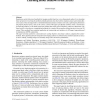Free Online Productivity Tools
i2Speak
i2Symbol
i2OCR
iTex2Img
iWeb2Print
iWeb2Shot
i2Type
iPdf2Split
iPdf2Merge
i2Bopomofo
i2Arabic
i2Style
i2Image
i2PDF
iLatex2Rtf
Sci2ools
CAE
2010
2010
Learning about Shadows from Artists
Renaissance artists discovered methods for imaging realistic depth on a two dimensional surface by re-inventing linear perspective. In solving the problem of depth depiction, they observed how shadows project and volumes flatten in nature. They investigated how controlled illumination projects volumes onto walls, exploring the phenomena long before physical optics, such as the camera, existed. This paper specifically examines artists' constructions for depicting shadows, a 3D double projection problem that artists solved completely within two dimensions. The larger goal is to develop new computational methods for creating 3D perceptions without having to leave the 2D canvas. Those methods have potential application in constructing user interfaces, in 2D image compositing and in simultaneous 2D/3D composition. This paper develops geometric constructions for casting shadows onto planar surfaces, adapted from artists' methods. Their algebraization for integration into imaging s...
| Added | 12 May 2011 |
| Updated | 12 May 2011 |
| Type | Journal |
| Year | 2010 |
| Where | CAE |
| Authors | Elodie Fourquet |
Comments (0)

